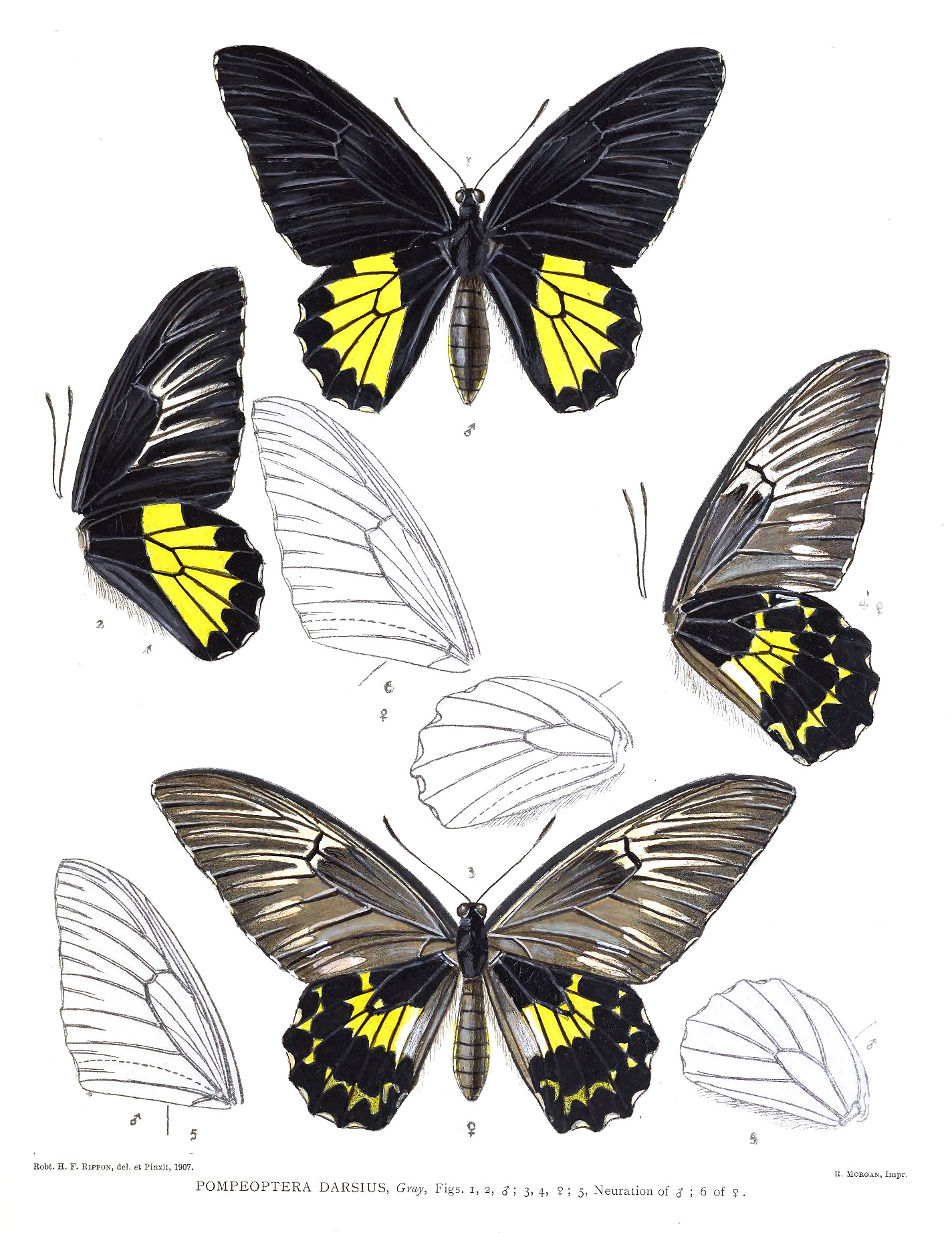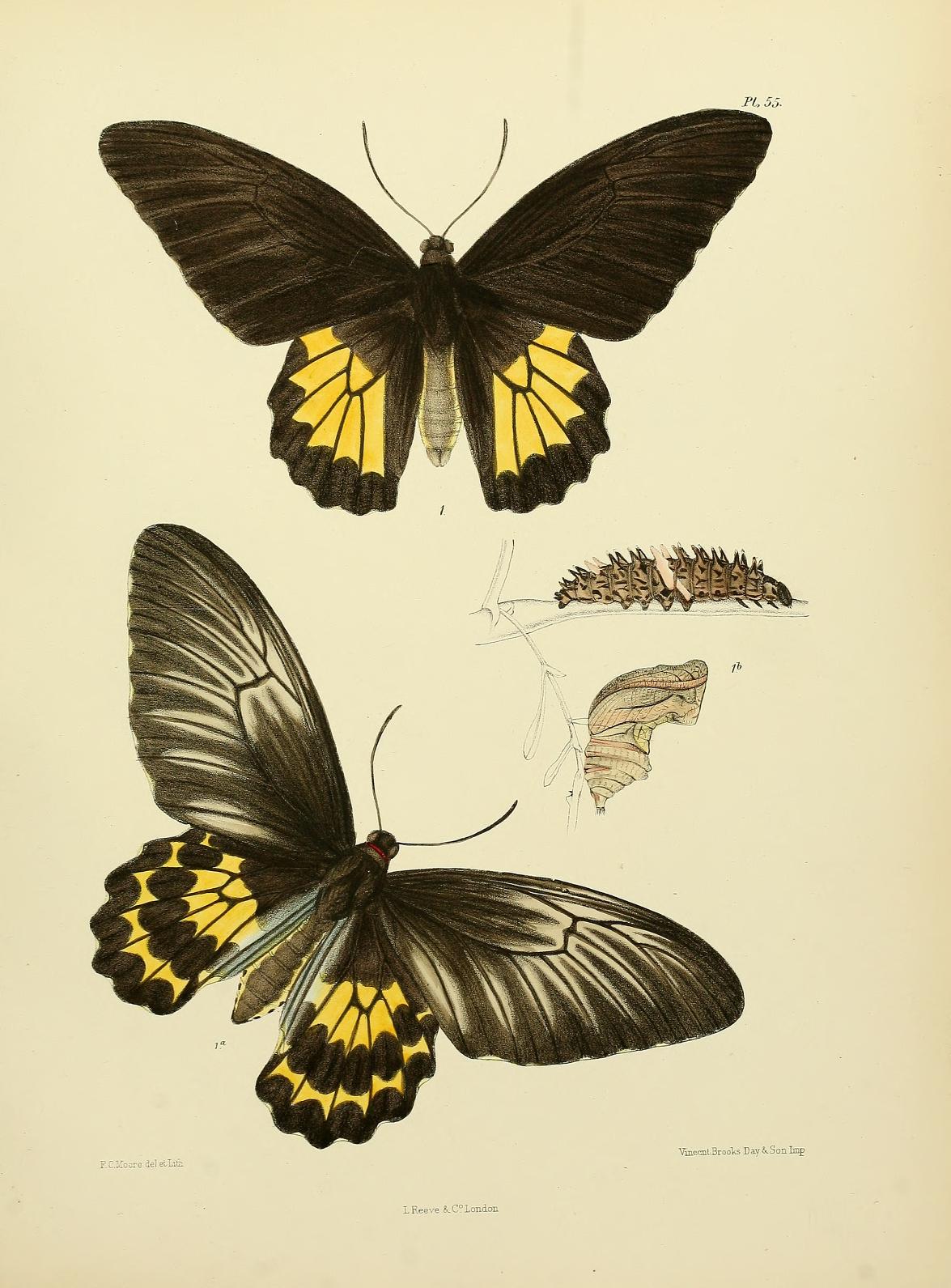Troides darsius on:
[Wikipedia]
[Google]
[Amazon]
''Troides darsius'', the Sri Lankan birdwing, is a 

Online guide to Butterflies of Sri Lanka
Images of the adult and life stages, descriptions
Images from
ARKive
Photos and more information
Sri Lanka Montane Rain Forests Ecoregion
{{Taxonbar, from=Q3539878 Darsius Butterflies of Asia Butterflies described in 1852 Taxa named by George Robert Gray
species
In biology, a species is the basic unit of classification and a taxonomic rank of an organism, as well as a unit of biodiversity. A species is often defined as the largest group of organisms in which any two individuals of the appropriate s ...
of birdwing butterfly
Butterflies are insects in the macrolepidopteran clade Rhopalocera from the order Lepidoptera, which also includes moths. Adult butterflies have large, often brightly coloured wings, and conspicuous, fluttering flight. The group comprise ...
found in Sri Lanka. It is the largest butterfly on the island and is also the national butterfly of Sri Lanka.
Among the largest and most gaudy of the Ceylon Lepidoptera is the great black and yellow butterfly (''Ornithoptera darsius'', Gray); the upper wings, of which measure six inches (15 cm) across, are of deep velvet black, the lower, ornamented by large particles of satiny yellow, through which the sunlight passes, and few insects can compare with it in beauty, as it hovers over the flowers of the heliotrope, which furnish the favourite food of the perfect fly, although the caterpillar feeds on the aristolochia and the betel leaf and suspends its chrysalis from its drooping tendrils.Tennant, 1859 Ceylon, Physical, Historical and Topographical
{{italic title
''Ceylon. An Account of the Island, Physical, Historical, and Topographical with Notices of its Natural History, Antiquities and Productions'' is a two-volume book from 1859 by James Emerson Tennent.
"There is no island in the worl ...

Description
From '' Troides helena cerberus'' it differs as follows: Male forewing: adnervular pale streaks not prominent on the upperside, more distinctly marked on the underside. Hindwing black, with a very broad discal slightly curved silky-yellow band or patch that extends beyond the cell from interspaces 2 to 7, and is composed of elongate outwardly emarginate yellow markings that are divided only by the black veins. In most specimens the inner margin of this band crosses the apex of the cell, but in many the cell is entirely black. Abdomen with some black markings beneath and a lateral row of black spots. Female: Differs from ''cerberus'' female in the much greater extent of the black on the hindwing. Interspace 1 with a pale dusky-white patch in the middle; interspace 7 with an inner and an outer yellow spot; cell entirely black or nearly so, sometimes, but rarely, with the yellow extended into the apex. Wingspan of 165–175 mm.
Life cycle
Larva
Cylindrical, dull purple brown, with two dorsal rows and anterior and lateral rows of fleshy tubercles, those on the eighth segment and a streak from its base to lower end of seventh segment being pale pink; between the tubercles are dark brown streaks. Feeds on '' Aristolochia'' (Moore.)Pupa
Pale purplish ochreous, bent backwards anteriorly; thorax conical, the top flattened and its sides angled; wing cases dilated and flattened laterally in the middle, their outer edge acute; two middle segments of abdomen with a dorsal pair of conical prominences. (Moore.)Habitat
The primaryhabitat
In ecology, the term habitat summarises the array of resources, physical and biotic factors that are present in an area, such as to support the survival and reproduction of a particular species. A species habitat can be seen as the physical ...
is thinly wooded mountain forests from sea-level up to an elevation of 2,000 metres. Occasionally observed in gardens but generally rare in lowlands.
Threats
''Troides darsius'' is threatened bydeforestation
Deforestation or forest clearance is the removal of a forest or stand of trees from land that is then converted to non-forest use. Deforestation can involve conversion of forest land to farms, ranches, or urban use. The most concentrated ...
.
Related species
''Troides darsius'' is a member of the ''Troides haliphron''species group
In biology, a species complex is a group of closely related organisms that are so similar in appearance and other features that the boundaries between them are often unclear. The taxa in the complex may be able to hybridize readily with each oth ...
. The members of this clade are:
*''Troides haliphron
''Troides haliphron'', the haliphron birdwing, is a birdwing butterfly confined to Sulawesi and the lesser Sunda Islands.
Description
''Troides haliphron'' is sexually dimorphic.
Male: The forewings are ground colour black. The veins are bord ...
'' (Boisduval, 1836)
*''Troides darsius'' (Gray, 853
*''Troides vandepolli
''Troides vandepolli'', the van de Poll's birdwing, is a montane birdwing butterfly occurring on Java and Sumatra. It is endemic for Indonesia and is protected by the Convention on International Trade in Endangered Species (CITES).
The species w ...
'' (Snellen, 1890)
*''Troides criton
''Troides criton'', the Criton birdwing, is a birdwing butterfly found on the islands of Morotai, Halmahera, Bali, Bacan, Ternate and Obi in Indonesia.
Description
''Troides criton'' is sexually dimorphic.
Male: The ground colour of the for ...
'' (C. & R. Felder, 1860)
*''Troides riedeli
''Troides riedeli'', or Riedel's birdwing, is a birdwing butterfly endemic to the Tanimbar Islands, part of the Maluku Islands archipelago in Indonesia.
Very little is known of the life history and distribution.
Biogeographic realm
Australasi ...
'' (Kirsch, 1885)
*''Troides plato
''Troides plato'', the silver birdwing, is a birdwing butterfly endemic to Timor.
Described forms are ''nychonia'' Jordan, 1908 (male), ''chitonia'' Jordan, 1908 (male), and ''delormei'' Le Moult, 1931 (female).
Taxonomy
Previously considered t ...
'' (Wallace, 1865)
*''Troides staudingeri
''Troides staudingeri'' is a birdwing butterfly in the genus ''Troides'' in the family Papilionidae. It is known from Leti Island, Moa Island, Kisar Island, Babar Island and Wetar Island.
Subspecies
*''T. s. staudingeri'' (Sermata, Luang, Baba ...
'' (Röber, 1888)
References
* * *D'Abrera, B. (1975) ''Birdwing Butterflies of the World''. Country Life Books, London. *Haugum, J. & Low, A.M. 1978–1985. ''A Monograph of the Birdwing Butterflies''. 2 volumes. Scandinavian Press, Klampenborg; 663 pp. *Kurt Rumbucher and Oliver Schäffler, 2004 Part 19, Papilionidae X. Troides III. in Erich Bauer and Thomas Frankenbach Eds. ''Butterflies of the World''. Keltern: Goecke & EversExternal links
Online guide to Butterflies of Sri Lanka
Images of the adult and life stages, descriptions
Images from
Naturhistorisches Museum Wien
The Natural History Museum Vienna (german: Naturhistorisches Museum Wien) is a large natural history museum located in Vienna, Austria. It is one of the most important natural history museums worldwide.
The NHM Vienna is one of the largest museum ...
(English/German)ARKive
Photos and more information
{{Taxonbar, from=Q3539878 Darsius Butterflies of Asia Butterflies described in 1852 Taxa named by George Robert Gray